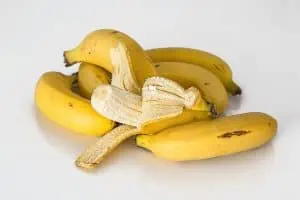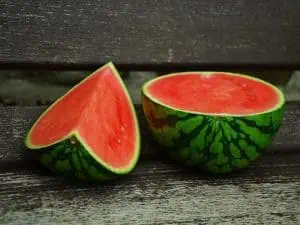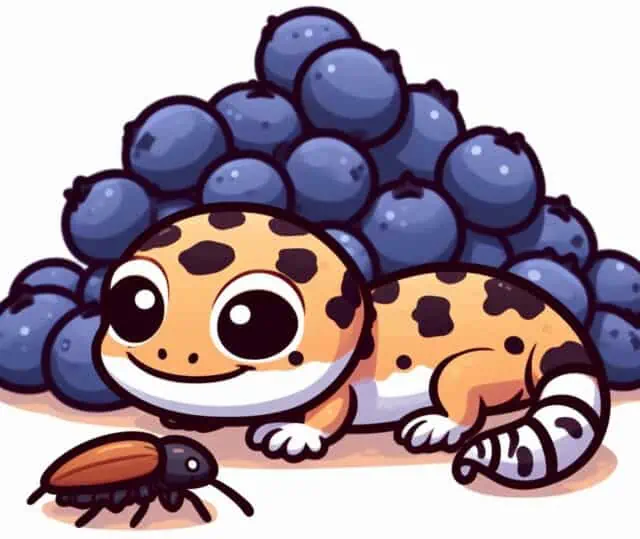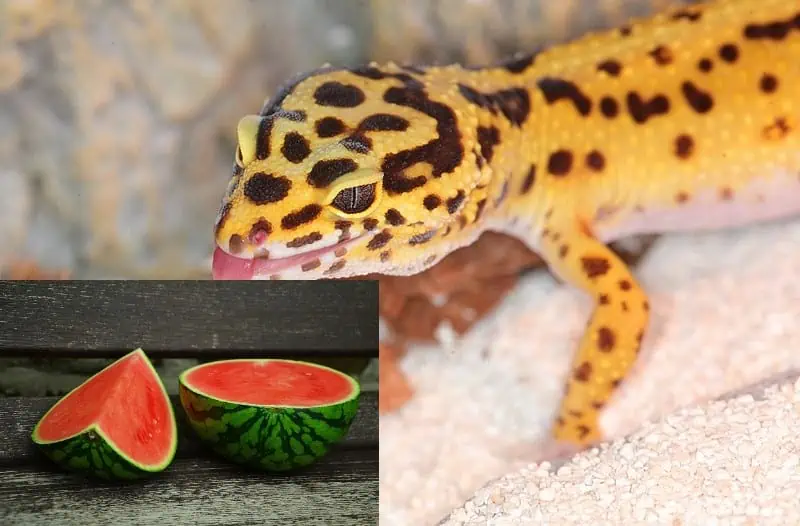Leopard Geckos are insectivores and their diet usually consists of crickets, mealworms, and some fatty worms as treats. Unlike other geckos, Leos are not omnivores, which means they can’t eat fruits and vegetables. This is why it’s very important to feed them the right type of food to remain healthy and happy.
In this article, we’ll talk about how Leopard Geckos react to fruits and what their diet is supposed to look like.
Insects, not fruits: Leopard geckos are fundamentally insectivores. Their digestive systems and dietary needs are tailored to process insects, not fruits.
Digestive Disadvantages: Leopard geckos have a short digestive tract, lack a cecum, and possess an alkaline gastrointestinal tract, making fruit digestion inefficient and potentially harmful.
Sugar Hazards: Fruits’ sugar content can lead to plaque buildup in leopard geckos, potentially causing mouth rot, infections, and even diabetes.
Anatomical Constraints: Their skull and jaw structure are specialized for an insectivorous diet, posing significant challenges and risks when trying to eat fruit.
Mineral Imbalance: Feeding fruits can disturb the critical calcium-to-phosphorus ratio of 2:1, making them prone to metabolic bone disease with severe consequences such as bone deformities.
Can Leopard Geckos Eat Fruit? What Types Are OK?
Leopard Geckos cannot eat fruit and most of them don’t like them at all. But some curious ones might like to nibble on a piece of fruit from time to time or simply lick a slice of mango. It’s up to the owner to decide whether their gecko can have a small piece of fruit or not. You need to know exactly how healthy your gecko is before giving it something that can cause complications.
These geckos lack the specific body part that is used to break down fruits and vegetables. This means that the gecko will go through a pretty painful digesting period after eating a big piece of fruit. Their bodies are simply not designed to deal with fruits. More than that, fruits are too high in sugar and acids to be consumed by Leos frequently.
In the wild, the only reason why a Leopard Gecko will eat fruit is if it’s starving and it doesn’t have another option. But there are also very few geckos that simply like the taste of some fruits. If you want to offer yours a bit of fruit, you will have to find out what it likes first. But this needs to be done over the course of a few years.
The best fruits for Leopard Geckos are mangos, bananas, peaches, raspberries, pears, apples, etc. But these fruits should only be given in very small quantities.
No matter what type of fruit your gecko might like, don’t ever give it to them in big pieces. You should chop them very well or slice them into very thin and small slices. But the best way to offer a Leopard Gecko fruit is to take a small piece and mix it until it turns into a puree. Then add a teaspoon of fruit-flavored baby food to the puree and mix very well.
This mix can be given to your gecko on a plate. The Leo will lick it slowly and the digestive process won’t be nearly as painful as eating big pieces of fruit. Another thing you need to keep in mind is that you should never give an insectivore gecko this mix more than one teaspoon a month.
Can Leopard Geckos eat strawberries?
Leopard Geckos will appreciate insects more, but if you want to give them a piece of fruit from time time, they might appreciate berries and strawberries are among the favorite. If your pet is one of those that love to try a bit of fruit from time to time, half a strawberry should be more than enough. Mix it with strawberry-flavored baby food to make it even more enjoyable. Blueberries might work as well.
Bananas

Apples
Apples are not typically the first choice among gecko keepers but they’re definitely OK in extremely small pieces. If you placed an apple in a smoothie maker, you can give your gecko a teaspoon of the apple puree before you add anything else to it. Don’t give it to your Leo if you already placed yogurt in it.
Peaches
Peaches are also adored by a few Leos and they’re easy to mix into a puree or cut into very thin slices. Just make sure you’re only offering the inside part that you’re also eating. And if your gecko prefers to lick the peach, instead of actually eating it, then it’s even better.
Watermelon

Watermelon is very easy to digest by almost anyone, which makes it a bit safer for Leos. But it should still be offered in small rations and only occasionally. If you have a dehydrated gecko that likes fruit, offering it a bit of watermelon can do more good than harm.
Pineapple
Pineapple is another tropical fruit that some Leos might like. You can mix it with baby food or something similar, including a few drops of pineapple juice, but only if it’s 100% natural. But only give this fruit in extremely small quantities as it’s high in acids. If you have other options, you can just avoid this fruit altogether.
Passion Fruit
Passion fruit should only be given to adult geckos, especially if you know they like to eat it. The younger Leos might have trouble swallowing the pieces. But if they’re licking a little bit off your hand is perfectly fine.
Mango
Mango is an excellent fruit for Leopard Geckos as well. It’s one of the most used tropical fruits in an omnivore gecko’s diet and a few insectivore geckos are known to love it as well. But if yours doesn’t like any fruit, don’t worry, it’s perfectly normal.
Kiwi
Kiwi can be offered to younger Leos that love fruit as well. The seeds are very tiny and if the fruit is cut into fine pieces, a juvenile can enjoy a few bites.
Oranges
Oranges are very high in acids and they should be avoided. They can cause some serious pain to your gecko if it actually ends up eating a piece. But almost no Leopard Gecko will eat an orange.
How much fruit can you give a Leopard Gecko daily?
Small Leos need to be fed between three times a day and once a day until they turn one year old. Then you can start feeding them once every two or three days. But this only includes insects and worms. Since Leopard Geckos don’t have the necessary mechanism to break down fruits, it’s best to avoid giving them any type of fruit daily.
If you only give them a very small amount of fruit mix, you can give it to them once a week. And if you only let them lick bigger fruits under your supervision, you can also do this once a week. But otherwise, it’s best to pick one day a month to give your Leo a tasty teaspoon of fruit puree.
Dangers of Feeding Fruit to Your Leopard Gecko
When it comes to the dietary needs of leopard geckos, fruit is a no-go. Let’s break down the reasons why.
First and foremost, fruits can lead to plaque buildup in a gecko’s mouth. Just like humans need to be wary of sweets for our dental health, the same caution applies to leopard geckos. This plaque buildup isn’t just unsightly; it can pave the way for infections. When fruit sugars linger in their mouths, it becomes a breeding ground for bacteria. This can lead to serious dental issues, like mouth rot, which is painful and potentially life-threatening for your gecko.
Next, there’s the risk of choking. Leopard geckos have evolved to munch on insects, not the soft, fibrous content of fruits. When they try to consume something they’re not used to, like a piece of fruit, they can easily choke on it. It’s not a pleasant sight, watching your pet struggle with something that’s supposed to be a treat.
Then, we have the internal complications. The digestive system of a leopard gecko isn’t cut out for processing fruits. This means that once the fruit gets past their mouth, it can cause havoc in their guts. Indigestion or diarrhea becomes a real threat. Remember, diarrhea is more than just an inconvenience for these little guys; it can quickly lead to dehydration, which is a serious concern.
In light of these dangers of feeding fruit, it becomes evident that such a choice is fraught with negative side effects. If you ever think about introducing fruit to your leopard gecko’s diet, always consult with a vet. They might guide you on specific situations where fruits can be offered safely, but these instances are rare and come with stringent guidelines. In most scenarios, it’s best to stick with the insects and other natural dietary options that have sustained leopard geckos for ages.
6 Reasons Why Leopard Geckos Shouldn’t Eat Fruit

Leopard geckos are captivating creatures with specific dietary needs, shaped by evolution and their unique biology. While they might seem like miniature dragons to some, their dietary requirements are far from mythical. Fruits, as tempting as they might be to offer as treats, are unsuitable for these reptiles for a multitude of reasons.
Short Digestive Tract
At the heart of the issue is the leopard gecko’s short digestive tract. This anatomical feature, while perfect for their natural insectivorous diet, poses challenges when it comes to digesting plant matter, including fruits. Think of it this way: certain animals have long, winding digestive tracts that allow them ample time and space to break down and absorb nutrients from plants. But that’s not the case with our leopard gecko friends.
Their short digestive tract signifies an inefficiency in digesting plant matter. Simply put, the intestines don’t have the length or the necessary mechanisms to break down and extract nutrients from fruits properly. When they consume fruits, these undigested bits can lead to a range of digestive issues. It’s not hard to imagine the discomfort a leopard gecko might feel, akin to stomach cramps in humans, due to this inability to fully digest fruit.
Moreover, this incomplete digestion can result in difficulty defecating.
They Lack A Cecum
A remarkable aspect of the leopard gecko’s digestive anatomy is the absence of a cecum. Now, you might be wondering, what’s a cecum, and why does it matter? The cecum is a pouch-like digestive organ found in many animals, primarily serving to aid in the breakdown of plants. It’s particularly vital for herbivores, as it harbors beneficial bacteria that assist in fermenting and digesting cellulose, a major component of plant cell walls.
Without a cecum, the leopard gecko’s ability to digest cellulose is drastically reduced. While herbivores rely on their cecum to process plants efficiently, leopard geckos, being insectivores, have evolved without this organ. Their diet in the wild mainly consists of insects, which don’t require the cecum’s specialized function for digestion.
Interestingly, leopard geckos aren’t the only animals that lack a cecum. Many carnivores and some insectivores also don’t have this organ, as their primary food sources are animal-based. This evolutionary adaptation points towards the specialized dietary needs of different species.
The Gastrointestinal Tract Is Alkaline, Not Acidic
Another noteworthy trait of the leopard gecko’s digestive system is its alkalinity. Unlike some animals that have an acidic gastrointestinal tract tailored to break down plant matter, leopard geckos possess an alkaline one. This difference isn’t just a minor nuance; it’s pivotal in their digestion process.
An alkaline gastrointestinal tract is primed for digesting animal proteins, like the insects leopard geckos naturally consume. On the other hand, an acidic environment, such as the one found in herbivores, is better suited for breaking down plant cellulose and extracting nutrients. When a leopard gecko is fed fruits or other plant matter, this alkaline system struggles. Simply put, the digestive environment isn’t acidic enough to handle and break down the components of fruits.
Feeding plant matter to an animal with an alkaline digestive system isn’t just inefficient; it can be detrimental. The improper breakdown of such foods can lead to complications, imbalances, and other health issues in the long run.
The Sugar Content And Its Dangers
While fruits might be nature’s candy for humans, the sugar content they carry can be a genuine concern for leopard geckos. Unlike us, these reptiles aren’t adapted to handle the natural sugars found in fruits, leading to a plethora of health issues if consumed in significant amounts.
One of the immediate concerns with sugar is plaque buildup. Just as humans need to brush their teeth to prevent plaque and cavities from sugary foods, animals also face dental challenges. For leopard geckos, plaque buildup from sugars can pave the way for mouth rot, a painful condition where infections set in, leading to inflammation and potential tooth loss.
But the dangers don’t just stop at dental issues. In the long run, a diet high in sugar can wreak havoc on a leopard gecko’s internal system. Excessive sugar intake can potentially lead to conditions like diabetes, where the body struggles to regulate blood sugar levels. Additionally, a sugary diet might also result in fatty liver disease, a condition where the liver becomes overloaded and inflamed due to high sugar consumption.
Wrong Skull & Jaw Shape
Anatomy plays a pivotal role in dictating dietary choices, and leopard geckos are no exception. If you ever get a close look at one of these creatures, you’ll notice their distinct skull and jaw shape. These features, while ideal for their insectivorous diet, pose challenges when it comes to consuming fruit.
The skull and jaw structure of leopard geckos is specialized to grasp and swallow small prey, especially insects, whole. This means they don’t have the same chewing ability as animals adapted to masticate plant matter. When faced with a piece of fruit, a leopard gecko would struggle significantly. They’re not equipped to break down chunky, fibrous foods effectively, which could lead to improper ingestion.
The risk doesn’t end with mere struggles. Due to their inability to chew properly, there’s a heightened risk of choking when attempting to eat larger or harder pieces of fruit. Additionally, even if they manage to swallow, the improperly chewed fruit can lead to digestive issues, given the body’s challenge in processing larger food particles.
Calcium & Phosphorus Imbalance
For animals, especially reptiles like the leopard gecko, maintaining a proper balance of essential minerals is crucial. One of the most critical balances to strike is that between calcium and phosphorus. Unfortunately, fruits can disrupt this equilibrium, posing significant health risks to the gecko.
When a leopard gecko’s diet leans heavily towards fruits or contains fruit regularly, it can lead to an imbalance in the calcium-to-phosphorus ratio. Ideally, their dietary intake should maintain a precise calcium-to-phosphorus ratio of 2:1. Fruits, being typically low in calcium and higher in phosphorus, can skew this balance in an unfavorable direction.
This disproportion of minerals can pave the way for metabolic bone disease (MBD), a debilitating condition for reptiles. MBD is a direct result of insufficient calcium or an imbalance between calcium and phosphorus. The symptoms and health problems associated with MBD can be varied and severe. They range from softening and weakening of bones, difficulty in movement, to deformities and fractures. In extreme cases, it can even prove fatal.
Ensuring that leopard geckos get the right balance of these essential minerals is paramount for their well-being. While fruits might seem like a tempting treat, the potential risks they bring, especially concerning the calcium & phosphorus imbalance, make them a poor dietary choice for these reptiles.





